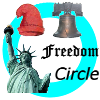Measures of Freedom
Human Freedom Index [PDF],
The Human Freedom Index 2021
2019: 4.93, Rank: 159, Personal Freedom: 3.68, Economic Freedom: 6.67
Level of Economic Freedom,
Economic Freedom of the World
2020: 6.03, Rank: 130
Somalia | Freedom House,
Freedom in the World 2022
2016: Status: Not Free, Aggregate Score: 2, Political Rights: 7, Civil Liberties: 7
In 2015, Somalia was plagued by much of the same political and security pitfalls that have characterized the country for the last quarter century. The government continued its halting progress toward transition in 2016, when the current administration's mandate expires. Critical transition-related legislation was largely ignored as lawmakers wrestled over an impeachment motion against the president. In July, President Hassan Sheikh Mohamud announced that national elections planned for 2016 would not be contested under a one-person, one-vote system.
Articles
America's Two Just Wars: 1775 and 1861, by
Murray N. Rothbard,
The Costs of War, May 1994
Based on a talk given at the Mises Institute's Costs of War conference, Atlanta, 20-22 May 1994
The Somalian intervention was a perfect case study in the workings of this Wilsonian dream. We began the intervention by extolling a "new kind of army" ... engaged in a new kind of high moral intervention: the U.S. soldier with a CARE package in one hand, and a gun in the other ... [T]he end of the brief Somalian intervention provided a great lesson if we only heed it: the objects of our "humanitarianism" being shot down by American guns, and striking back by highly effective guerrilla war against American troops, culminating in savaging the bodies of American soldiers.
Are the Salad Days for Somalia Over?, by
Lew Rockwell,
Mises Daily, 8 Jun 2006
Comments on the status of Somalia 15 years after the fall of Siad Barre and in the midst of the rise of the Islamic Courts Union
Fifteen glorious years without a central government in Somalia! ... The dictator Mohammed Siad Barre fell in 1991. US troops went in with the idea that they would restore order, but thank goodness they did not. Bill Clinton's idea fell into shambles after 18 soldiers were killed by warlords ... Since that time, Somalia has done quite well for itself, thank you (BBC: "Telecoms Thriving in Lawless Somalia"). But there was one major problem. The CIA couldn't come to terms with it ... Now the United States has a bigger problem than ever: the possibility that a new Taliban has been created in Somalia.
'Doing God's Work', by
Murray N. Rothbard,
The Rothbard-Rockwell Report, Mar 1993
Detailed history of Somalia from its independence in 1960 to the United Nations-sanctioned invasion in Dec 1992, with particular emphasis on the effects of U.S. government and private aid
So the question is: how could Somalia, a land that used to be self-sufficient in food, have gotten to the point where virtually everyone seems to be dependent on U.S. and other outside relief? ... In short, the food 'crisis' has been deliberately created by the Somalian government – by Barre and his successors – in order to exert control over the Somali population, to tell them when and who shall or shall not eat.
Domestic Fear Is the Price of Empire, by
Sheldon Richman, 25 Feb 2015
Comments on threats against Americans and Canadians from the Somali al-Shabaab organization and recounts U.S. intervention in Somalia since the 1990s
U.S. intervention goes back to 1992, when President George H.W. Bush sent the military into a civil war there. Among the military's activities was the suppression of the Somalis' use of the intoxicant khat, which has been part of their culture for millennia. That's right. The U.S. government imposed a war on the Somali drug of choice. President Bill Clinton withdrew the forces after two Blackhawk helicopters were shot down, but that was not the end ... After the September 11 attacks, Somali warlords seeking American largess played on the George W. Bush administration's concerns about al-Qaeda. The CIA obliged the warlords with suitcases of cash.
The Kenyan Massacre’s Roots in America's Somalia Policy, by
Sheldon Richman, 24 Sep 2013
Comments on the 21 Sep 2013 Westgate shopping mall shooting in Nairobi, based on reporting on Somalia's situation by Scott Horton and Jeremy Scahill
[The] U.S. government has intervened directly in Somalia and backed repeated invasions by neighboring African states ... In the process, a relatively moderate government was overthrown, resistance to invaders was radicalized, and the al-Qaeda-linked al-Shabaab gained partial control, which would have been unlikely without that intervention ... Somalia's Islamic Courts Union, a coalition of a dozen groups, put down the warlords and the U.S.-sponsored Transitional Federal Government. "The ICU then declared the reign of Islamic law," Horton writes ... This was unacceptable to the Bush administration ...
Somalia: US Foreign Policy and Gangsterism, by
Justin Raimondo, 29 Dec 2006
Provides background on Somalia from 1993 to 2006 (the warlords period up to the Islamic Courts) and insights into the Ethiopian invasion backed by the United States
The failed UN/U.S. intervention of 1993 led directly to the triumph of the warlords, who plundered, raped, and murdered their way through the streets of Mogadishu ... and reduced the country to Mad Max territory ... an "Islamic courts" movement sprang up to impose some sort of cohesion on a rapidly disintegrating social order. The business community and public opinion rallied behind these courts, which were and are all that stand between civilization and savagery in Somalia ... it's Raghe, the street punk and gang leader, who, together with his fellow killers, has reduced Somalia to a kind of living hell.
